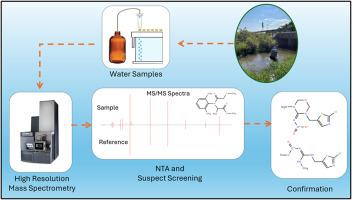封闭生物乙醇生产设施周围地表水和地下水中农药及其转化产物的非目标分析鉴定
IF 7.3
2区 环境科学与生态学
Q1 ENVIRONMENTAL SCIENCES
引用次数: 0
摘要
采用非靶向分析(NTA)方法对美国内布拉斯加州一个废弃生物乙醇生产设施周围地表水和地下水中的36种农药和转化产物进行了鉴定。该设施储存和加工农药处理过的种子作为生物乙醇原料,这导致农药大量释放到周围环境中。之前曾使用靶向化学方法监测周围地表水的22种农药和选定的tp,包括新烟碱类杀虫剂和strobilurin杀菌剂,尽管可能存在的全部农药和其他化学物质尚不清楚。2021年的目标样品提取物采用液相色谱和飞行时间质谱(LC-Q-ToF)对NTA进行回顾性分析,以确定之前未选择用于分析的其他化学物质。NTA鉴定出16种农药和20种tp,其中33种与标准品一致。在检测到的20个TPs中,有17个未包括在先前的靶向分析中。使用三重四极杆串联质谱(LC-MS/MS)进行半定量分析,确定了最丰富的TPs的估计浓度。总磷的估计浓度通常高于母体农药,在地表水中有几个总磷达到中μg/L到低mg/L的范围,超过了EPA水生生物基准。2023年9月收集了地表水样本,2024年6月收集了地下水样本,以提供受影响地区化学概况的最新信息,发现2021年检测到的16种农药和TPs仍然存在,尽管浓度普遍低于2021年观察到的浓度。本文章由计算机程序翻译,如有差异,请以英文原文为准。

Identification of pesticides and their transformation products in surface water and groundwater surrounding a closed bioethanol production facility using non-targeted analysis
Non-targeted analysis (NTA) was used to identify 36 pesticides and transformation products (TPs) in surface and groundwater surrounding a defunct bioethanol production facility located in Nebraska, USA. The facility had stored and processed pesticide-treated seeds as bioethanol feedstock, which resulted in significant releases of pesticides to the surrounding environment. Targeted chemical methods were previously used to monitor the surrounding surface water for 22 pesticides and select TPs, including neonicotinoid insecticides and strobilurin fungicides, although the full range of pesticides and other chemicals that may have been present was unknown. Targeted sample extracts from 2021 were retrospectively analyzed with NTA using liquid chromatography and time of flight mass spectrometry (LC-Q-ToF) to identify additional chemicals not previously selected for analysis. Sixteen pesticides and 20 TPs were identified in the sample extracts with NTA, 33 of which were confirmed with a reference standard. Of the 20 detected TPs, 17 were not included in the previous targeted analysis. Estimated concentrations were determined for the most abundant TPs using a follow-up semi-quantitative analysis with triple quadrupole tandem mass spectrometry (LC-MS/MS). TP estimated concentrations were typically higher than the parent pesticides, with several TPs reaching the mid-μg/L to low-mg/L range in surface water and exceeding EPA aquatic life benchmarks. Surface water samples were collected in September 2023 and groundwater in June 2024 to provide an update on the chemical profile of the impacted area, which found 16 of the pesticides and TPs detected in 2021 still present, although generally at lower concentrations than observed in 2021.
求助全文
通过发布文献求助,成功后即可免费获取论文全文。
去求助
来源期刊

Environmental Pollution
环境科学-环境科学
CiteScore
16.00
自引率
6.70%
发文量
2082
审稿时长
2.9 months
期刊介绍:
Environmental Pollution is an international peer-reviewed journal that publishes high-quality research papers and review articles covering all aspects of environmental pollution and its impacts on ecosystems and human health.
Subject areas include, but are not limited to:
• Sources and occurrences of pollutants that are clearly defined and measured in environmental compartments, food and food-related items, and human bodies;
• Interlinks between contaminant exposure and biological, ecological, and human health effects, including those of climate change;
• Contaminants of emerging concerns (including but not limited to antibiotic resistant microorganisms or genes, microplastics/nanoplastics, electronic wastes, light, and noise) and/or their biological, ecological, or human health effects;
• Laboratory and field studies on the remediation/mitigation of environmental pollution via new techniques and with clear links to biological, ecological, or human health effects;
• Modeling of pollution processes, patterns, or trends that is of clear environmental and/or human health interest;
• New techniques that measure and examine environmental occurrences, transport, behavior, and effects of pollutants within the environment or the laboratory, provided that they can be clearly used to address problems within regional or global environmental compartments.
 求助内容:
求助内容: 应助结果提醒方式:
应助结果提醒方式:


